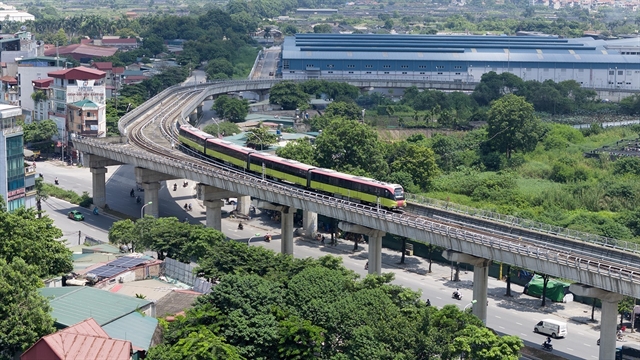 |
| The Nhổn – Hà Nội Station Metro Line was recently put into operation after a decade of delay. The Ministry of Transport said priority will be given to developing the railway infrastructure to 2030 with a vision to 2050. — VNA/VNS Photo Tuấn Anh |
HÀ NỘI — In the overall long-term plans for Việt Nam’s transport network, the Ministry of Transport has said priority will be given to developing and funding the national railway.
The project of developing transport infrastructure to 2030 with a vision to 2050, aims to take advantage of rail’s ability to transport large volumes, at speed, safely and conveniently, while offering environmental positives.
Việt Nam’s transport infrastructure is developing rapidly but losing balance as investments focus mainly on road, marine, air and inland waterway transports, Lưu Quang Thìn, deputy director of the ministry’s Department of Planning and Investment, said.
Meanwhile the railway system has not been prioritised in terms of investment and has become significantly outdated. Urban railway projects are stagnating, which makes them fail to play fully their potential role in reducing traffic congestion and environmental populations in major urban areas.
This was because of the shortage of capital for transport infrastructure development, he said.
The Ministry of Transport will focus on developing the North-South high-speed railway and speeding up the progress of urban railway projects in Hà Nội and HCM City to reduce congestion, as well as improving the connectivity to form a convenient passenger transportation network across the country.
It is estimated that Việt Nam will needs around US$151.2 billion to invest in railway infrastructure system by 2030 and $312 billion by 2050.
The ministry also said it wants Việt Nam to have 5,000km of expressway by 2030, focusing on routes connecting major economic hubs, seaports, airports and international border gates to meet the huge demand for cargo transport. Việt Nam will need $24.8 billion by 2030 and $33.64 billion by 2050 to develop the road system.
Around $10.8 billion is needed by 2030 to develop inland waterways and a sum of $4.8 billion is needed by 2050.
Việt Nam will continue to expand international ports in Lạch Huyện and Bà Rịa – Vũng Tàu and call for investments in Cần Giờ, Vân Phòng, Trần Đề ports. Under the plan, the country will need $4.16 billion by 2030 to upgrade the marine transport system and $6.65 billion by 2050.
Regarding air transport, priority will be given to developing the major airports in HCM City and Hà Nội, gradually upgrading 22 existing airports and calling for investments in new airports. The total investment is estimated at $17.1 billion by 2030 and $21.06 billion by 2050.
The transport ministry will continue to improve the legal framework to attract investments from different economic sectors into developing the transport infrastructure.
A list of projects is being developed to call for investments from public-private partnerships and foreign investments by 2030 and onward.
The ministry’s statistics showed that Việt Nam has developed 24,300km of national roads, 2,000km of expressways, 6,800km of inland waterways, 2,640km of national railway, 298 ports and 22 airports. — VNS
- Reduce Hair Loss with PURA D’OR Gold Label Shampoo
- Castor Oil Has Made a “Huge” Difference With Hair and Brow Growth
- Excessive hair loss in men: Signs of illness that cannot be subjective
- Dịch Vụ SEO Website ở Los Angeles, CA: đưa trang web doanh nghiệp bạn lên top Google
- Nails Salon Sierra Madre
 VnExpress News The News Gateway of Vietnam
VnExpress News The News Gateway of Vietnam




